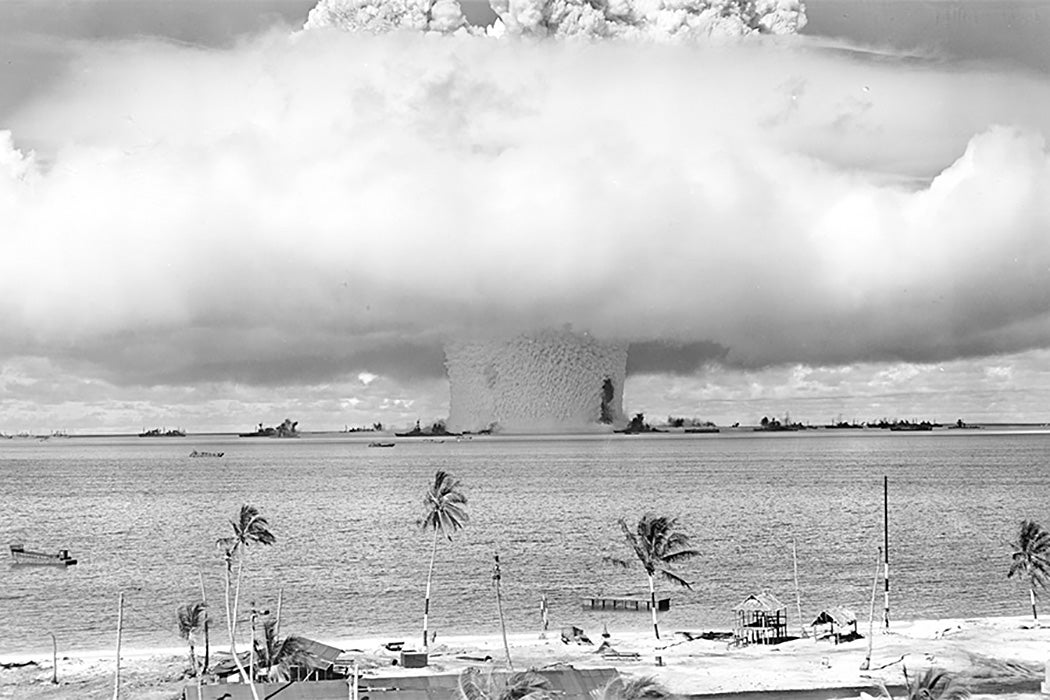Why Is It a Dumb Idea to Drop the Atomic Bomb Again
After the atomic bombings of Hiroshima and Nagasaki in August 1945, the U.S. attempted to suppress information about radioactivity—the very thing that fabricated these new bombs different from all weapons of war before them. The tremendous explosive power of the A-bombs was stressed, even historic, but officials worked hard to go along people ignorant of the terrible effects of radiation poisoning, effects which seem to take surprised many who worked on the bombs and ordered their use.
Scholar Janet Farrell Brodie explores how officials tried to "limit public understanding" of these poisonous afterwards-effects. She approaches this history through the lens of agnotology, the study of the cultural production of ignorance and/or doubt, the ways "lack of noesis has been fomented, cultivated, and maintained." Hiding the reality of radioactivity was an early on use of strategies that have since become commonplace, helping to undermining trust in institutions, both public and private.
The first Japanese responders to the bombings had no idea what was sickening people. They initially thought that a chemical or germ warfare device had accompanied or been a office of the bombing. (American officials were extremely worried about being labeled state of war criminals for using chemical or biological weapons.) Past the end of that August, Japanese doctors and scientists realized they were dealing with "radiation sickness" or "roentgen disease." Yet Japanese case notes, biopsies, slides, and other pieces of evidence were confiscated by U.Due south. occupation government—some of it kept classified for decades.
"Although the earth quickly learned a few details—that some kind of "atomic plague" related to the atomic flop was causing death and illness in the two bombed cities, U.S. authorities in Nippon and at home moved apace to incorporate deeper knowledge about the radiation and its effects."
Betwixt the Hiroshima (August 6) and Nagasaki (August nine) attacks, for example, the New York Times ran 132 news items about the bombings "just omitted or obscured anything about radiations." In the ten months after the Nagasaki blast, the Times had 15 articles mentioning radiations, nine of them minimizing it, the rest more than cryptic. J. Robert Oppenheimer of the Manhattan Project, equally an example, was quoted as saying "at that place is every reason to believe that in that location was no appreciable radioactivity on the ground in Hiroshima."
Censorship and lies were only partially successful. The story of the poisonous effects of radioactive decay unleashed by the A-bombs inevitably leaked out. Massive radiation contamination by A-bomb testing in the Pacific, which affected soldiers, examination animals, and naval ships, added to the inevitable revelation of the grim realities of the nuclear age.
And when information technology became impossible to fully censor the story, misdirection came into play. Upbeat messaging "about the medical and biological benefits to be gained from radiation" and the "peaceful uses" of atomic power attempted to paper over the horrible burns, painful sickness, agonizing deaths, and genetic mutations caused by radioactivity.
Weekly Newsletter
Brodie's synopsis of the efforts undertaken by officials could be used as a generic description of any number of once-underground stories, governmental and corporate, since: "Officials censored, suppressed, and distorted information through campaigns of misinformation and campaigns of reassurance."
Related

Bombs and the Bikini Atoll
October xiii, 2020
The haute beachwear known as the bikini was named afterward a string of islands turned into a nuclear wasteland by atomic bomb testing.
All this secrecy had consequences. Survivors were stigmatized and received no recognition or financial assistance from the Occupation (until 1952) or the Japanese government (until 1954). The U.S. written report set up in 1946 to measure out long-term furnishings of the bombing was specifically non allowed to provide medical treatment. Those afflicted by radiation from Nevada test sites, and flop-production and storage facilities in the U.Southward., were similarly ignored. As Brodie writes, "secrecy, extraordinary levels of classification, lies, denial, and deception became the chief legacy of the initial impulse to censor radiations data."
Support JSTOR Daily! Join our new membership program on Patreon today.

Resource
JSTOR is a digital library for scholars, researchers, and students. JSTOR Daily readers can access the original research behind our articles for gratis on JSTOR.
Journal of Social History, Vol. 48, No. 4, E.P. Thompson afterward L Years (Summer 2015), pp. 842-864
Oxford University Press
Bring together Our Newsletter
Source: https://daily.jstor.org/hiding-the-radiation-of-the-atomic-bombs/
0 Response to "Why Is It a Dumb Idea to Drop the Atomic Bomb Again"
Enregistrer un commentaire